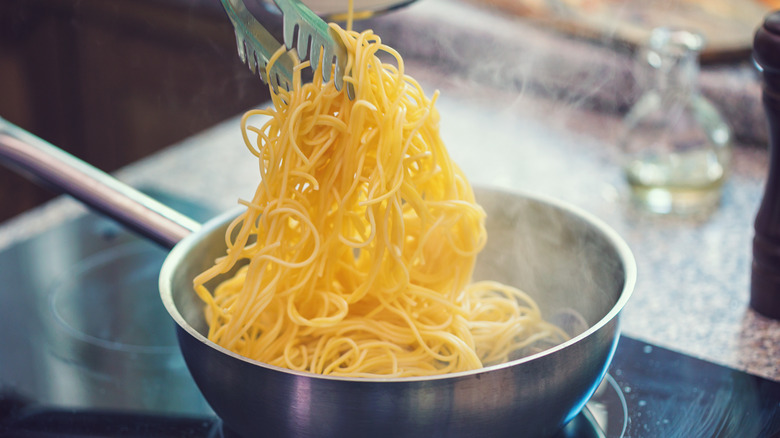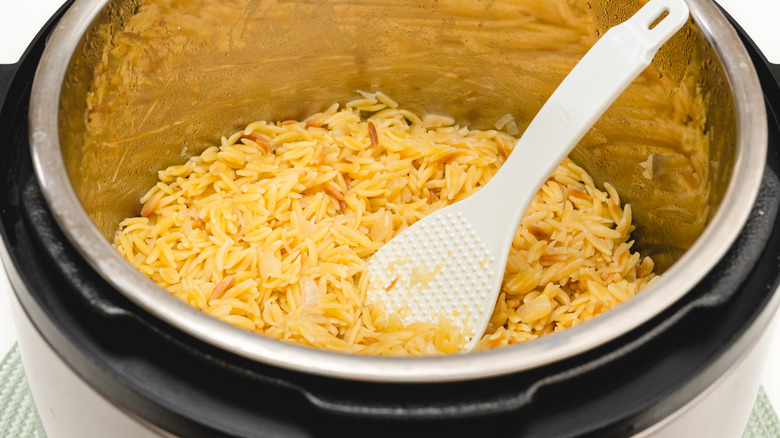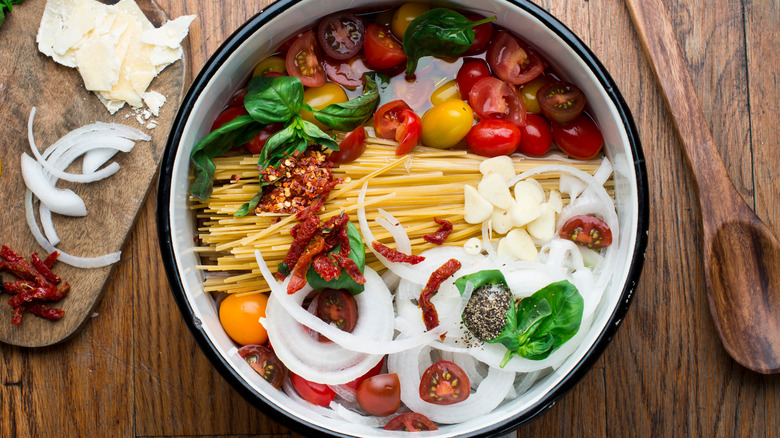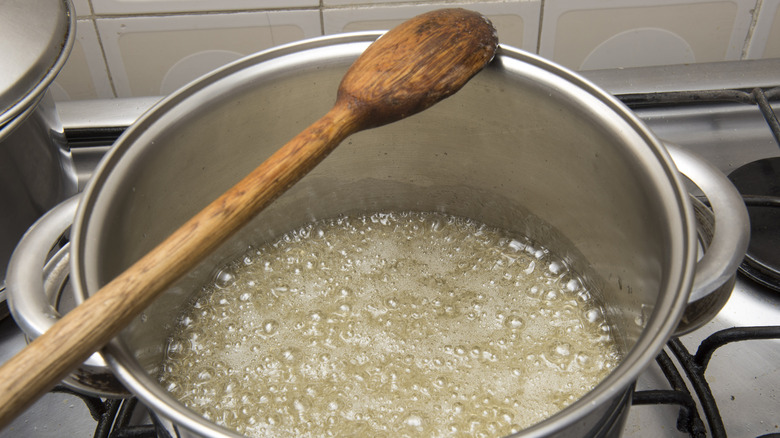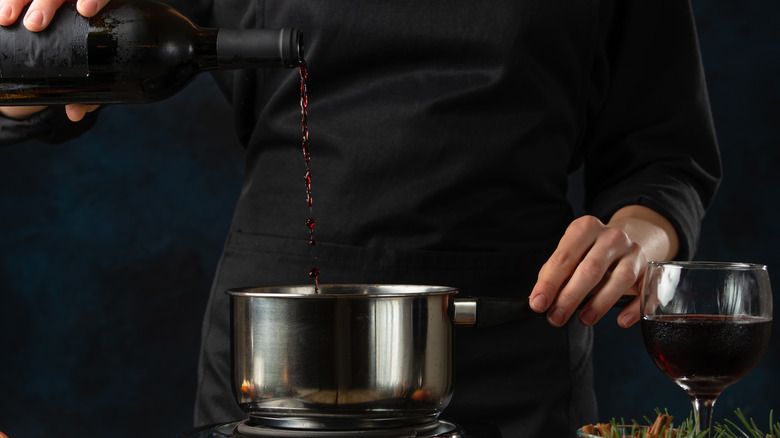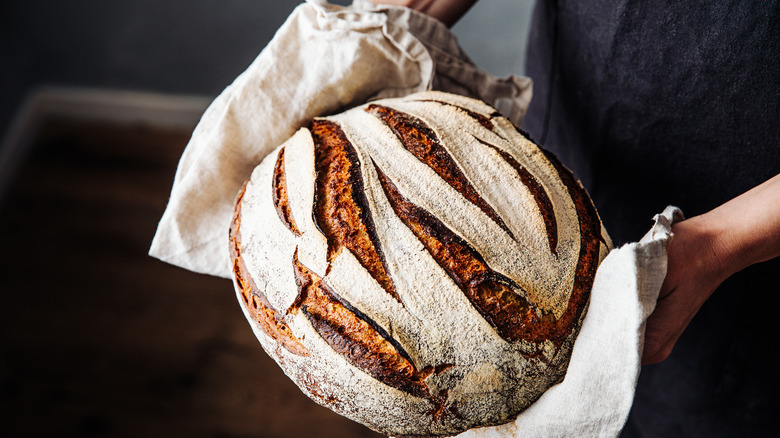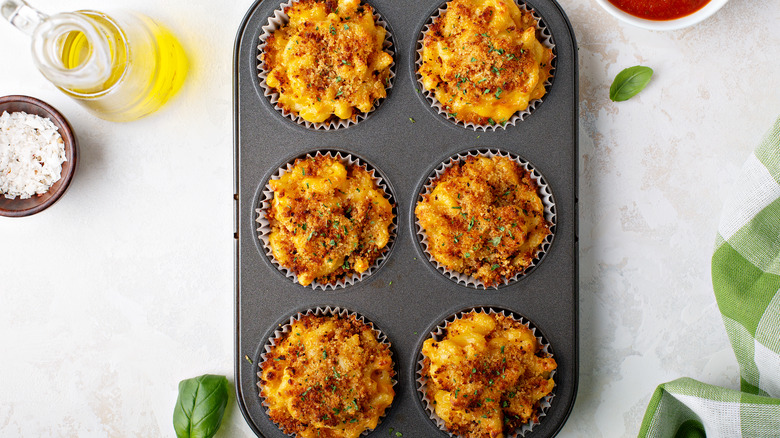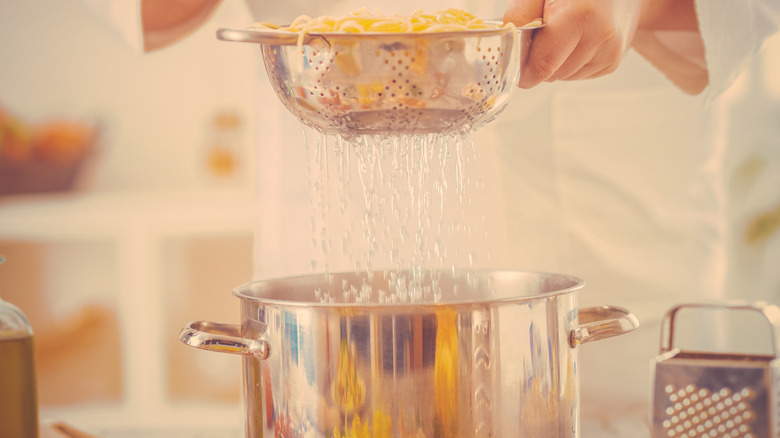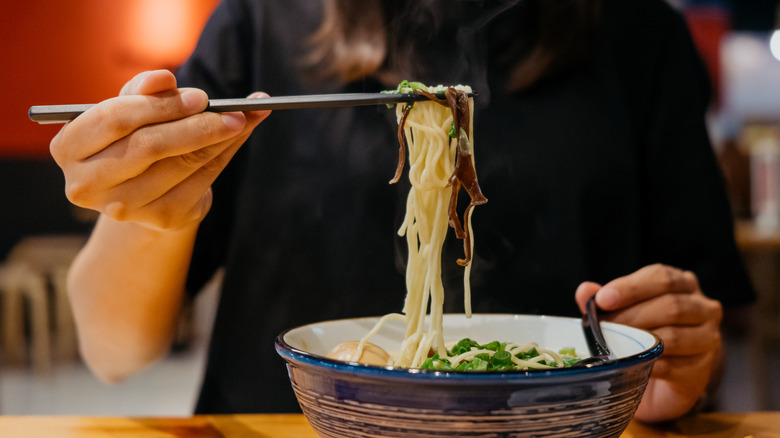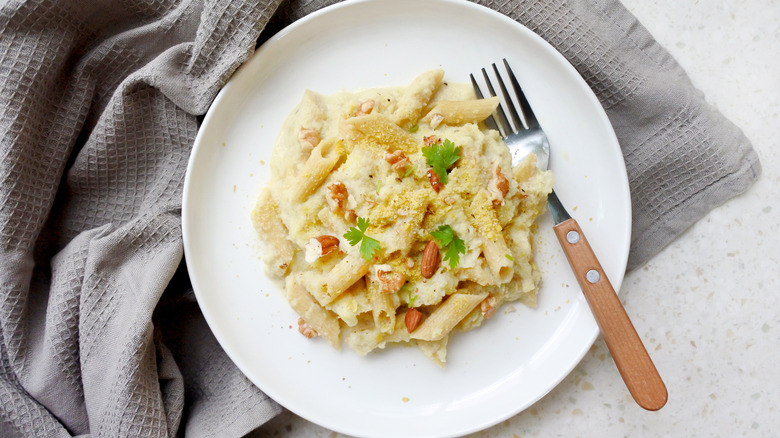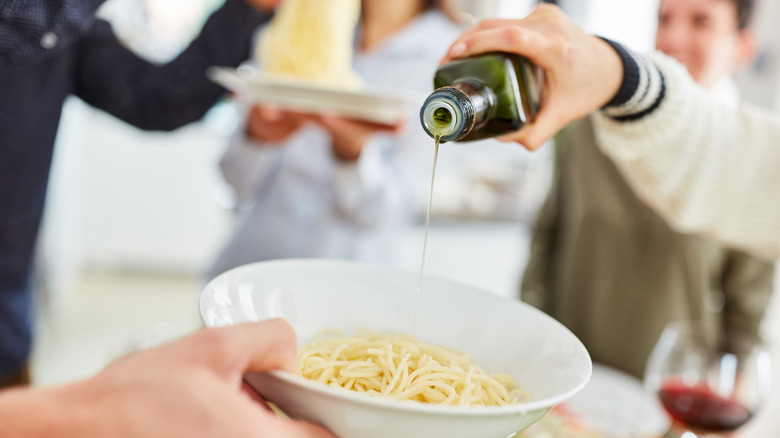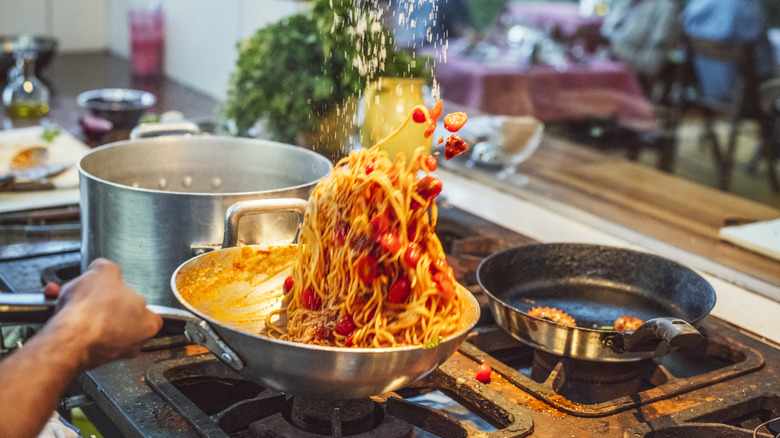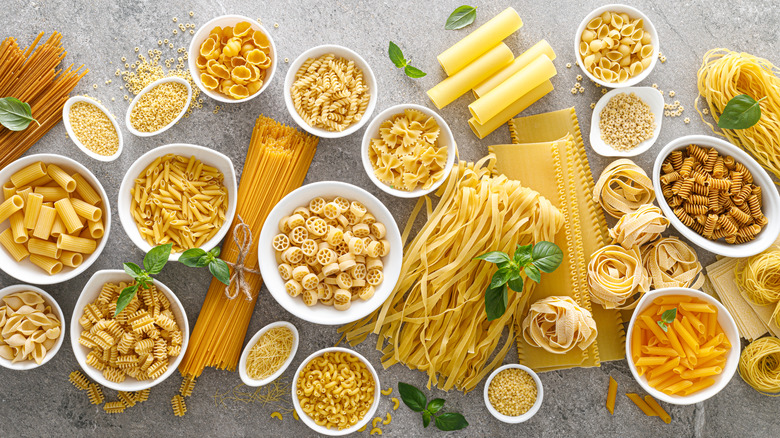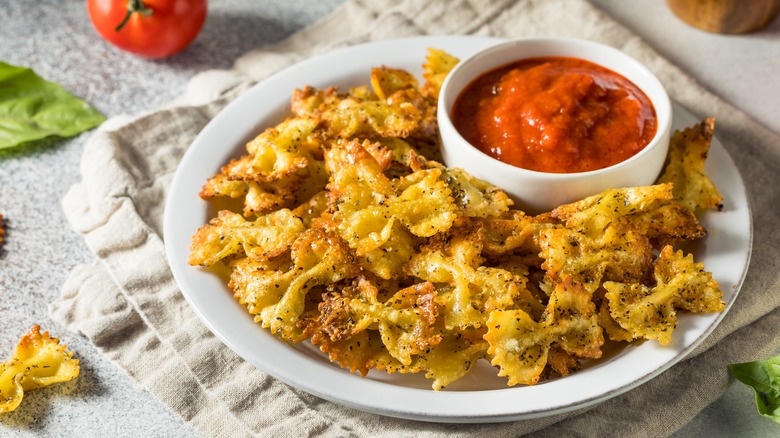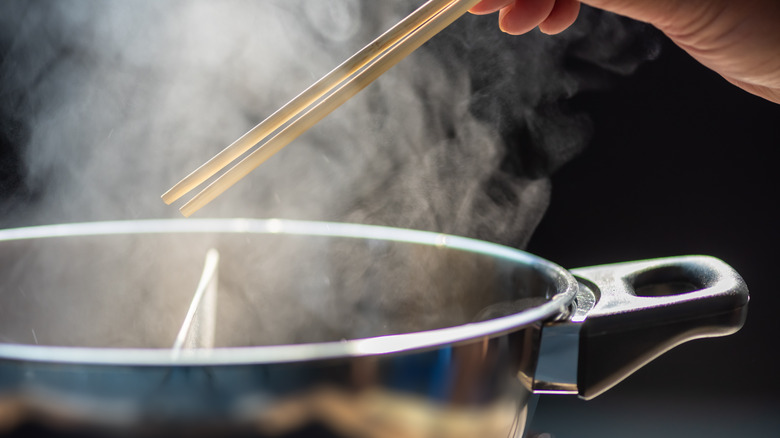14 Pasta Cooking Hacks That Are Actually Useful
Forget the works of Michelangelo or Leonardo, pasta might just be the best thing to come out of Italy. From rich, creamy sauces to simple preparations of nothing but garlic and olive oil, there are so many ways to enjoy pasta. It's commonly eaten as a starter in Italy, but we're more than happy to pile our plates with it as a hearty main.
You might already know how to cook pasta perfectly al dente, and how to avoid common pasta cooking mistakes, but there are more secrets in the world of this delicious starchy food than you might realize. You've probably seen a few pasta cooking hacks in your time, but how many are worth their salt — or the amount of salt needed to season your pasta water?
We've done deep research and plumbed our own knowledge to come up with 14 pasta cooking hacks that are actually useful. You won't find any hacks here that take more effort than they say or leave you with subpar pasta. You'll find tips for next-level noodles that you'll soon be adding to your cooking repertoire.
1. Make pasta in a rice cooker
Who doesn't love an appliance that can do multiple things? Rice cookers are already stars in the kitchen when it comes to cooking fluffy rice, and some of them can also handle quinoa, oats, and other grains. But you might not know that they can cook pasta, too. You might be wondering why you'd want to cook pasta in a rice cooker, but there are a number of reasons you may be overlooking. If you're cooking an elaborate feast on a small stove, your other burners might already be taken up with frying onions, simmering sauce, or braising veggies, leaving no room for pasta. Cooking it in a separate appliance means you free up a burner.
It's also a more hands-free way of cooking. Instead of waiting for that huge pot of water to boil, you can simply toss the pasta in the rice cooker, add water or broth, set the timer, and go chill out on the couch. Your trusty rice cooker will take care of the rest, and in no time, you'll have perfectly cooked pasta waiting for you. It takes around 6 to 12 minutes to cook, depending on the pasta's size and shape. It may take a little trial and error to get it just right. Don't fill the cooker more than half to two-thirds full to keep it from overflowing.
2. Cook pasta directly in its sauce
Cooking pasta directly in its sauce is a game-changer. The noodles absorb all the delicious flavors and become infused with the goodness of the sauce. Think about it — when you boil pasta separately and then toss it with sauce, sure it gets coated, but it's not the same as when they're cooked together from the get-go. When you simmer pasta in its sauce, the ingredients meld together, and create a treat for your taste buds.
Another bonus is that it's a one-pot wonder. No need to dirty an extra pan for the sauce. All the ingredients are cooked at the same time, with the pasta absorbing the extra liquid from the sauce. No draining, no fuss, no mess — just a delicious, saucy pasta party. Plus, cooking pasta in its sauce allows you to control the consistency better. If you prefer a thicker sauce, you can let it reduce. On the other hand, if you like it a little more soupy, you can adjust the liquid accordingly. It's all about making it exactly the way you love it.
However, you can't simply throw dry pasta in a pan with jarred sauce and expect it to cook. There's not enough liquid and the pasta won't cook fully. Instead, you need to follow a one-pot pasta recipe. This way, the ratios will be just right, and you'll end up with something delicious.
3. Use a wooden spoon to prevent pasta water overflow
Have you ever faced the frustration of your pasta boiling over and creating a starchy mess all over your stove? Well, you don't need to worry about it anymore, because the mighty wooden spoon is here to rescue you. Here's the deal: the wooden spoon hack is a kitchen trick that's been passed down through generations. It's simple, it's effective, and it can save you from scrubbing dried starch off your stove. The next time you're boiling pasta, just grab a trusty wooden spoon, preferably a long one, and place it horizontally over the top of the pan. That's it — problem solved.
It's one of those hacks that you might have heard about but not believed because, frankly, it sounds made up. But there is some science at work. The rough texture of the wooden spoon causes bubbles to burst as they get close to boiling over. And since wood is a poor conductor of heat, it stays cooler than the bubbles and the pot, helping burst errant bubbles. So, now you can spend more wine enjoying your pasta and less time cleaning up.
4. Cook pasta in red wine for a flavorful meal
Wine lovers, take note. There's a culinary trick that'll tickle your taste buds and take your pasta game to a whole new level — cooking pasta in red wine. Now, before you raise an eyebrow and ask, "Cooking pasta in wine? Is that even a thing?" let us tell you why it's totally worth a shot. Red wine adds a rich, robust flavor to the pasta that's simply divine. It infuses the noodles with fruity, earthy notes, turning your pasta into a gourmet masterpiece.
The best part is that you don't have to splurge on a fancy bottle of wine. You can use an affordable one that you enjoy drinking, and you'll still get that amazing depth of flavor in your pasta. The process is simple — you boil your pasta with some wine and mix it with enough water to fill up the pot you're using. Then, there are all kinds of variations, such as frying onions and garlic separately, and adding a little reserved wine to create a sauce. It's fairly easy to wing it, but the first time you make it, it's best to follow a dedicated red wine pasta recipe, especially if you're not used to going without a recipe.
5. Use pasta water to make bread
Allow us to blow your mind with a fantastic kitchen hack that's thrifty, creative, and delicious — using leftover pasta water to make bread. Yep, you read that right, and it's a genius way to reduce food waste and add some magic to your homemade bread. You've just cooked up a scrumptious pot of pasta, and now you're left with that pot of starchy water. Instead of pouring it down the drain, save it. That pasta water is packed with all the goodness and flavors from the pasta you just cooked.
Now, when you're ready to whip up a loaf of fresh, homemade bread, it's time to put that pasta water to work. When making bread, the liquid you use is essential for creating that perfect, soft, and airy texture. Instead of using plain water, why not give your bread a flavor boost with pasta water? Simply use your saved pasta water in place of the regular water in your bread recipe. The starch in the water helps improve the bread's structure and moisture, resulting in a beautifully tender crumb. You'll also get some subtle extra flavor from the pasta. It combines two of our favorite things, so you really can't go wrong.
6. Bake leftover pasta in muffin tins
It's easy to cook too much pasta. And while it's possible to freeze it or reheat it, you might be looking for another way to repurpose it. Well, there's a super fun and tasty way to turn your leftover pasta into a delightful treat — baked pasta muffins. It really mixes things up when it comes to reimagining your pasta leftovers.
So, why bake pasta in muffin tins? Well, it's all about that perfect bite-size goodness. Muffin tins create individual portions, making these pasta muffins an ideal grab-and-go snack or a cute party appetizer. All you do is mix your leftover pasta with egg, cheese, blended seasoned silken tofu, or a combination of these ingredients to bind the pasta together. Then spoon it into muffin tins and bake for 10 minutes or so, until the mixture is solid and holding together, and the pasta has started to crisp slightly on top. It works best with spaghetti, tagliatelle, and other long pasta, but you can experiment with short pasta shapes, too. You'll just need to use extra binder ingredients.
7. Improve your pasta sauce with pasta water
There's a simple pasta hack for creating the most perfectly silky pasta sauce — using some of the water you just boiled your pasta in. That humble, starchy liquid has hidden powers that can transform your sauce from good to gourmet. Before you pour that pasta water down the drain, save a cup or so of it. That water is your secret ingredient for a better sauce.
When you cook pasta, it releases starch into the water, making it slightly thick and velvety. When you incorporate this water into your sauce, that starch works its magic, creating a luscious, creamy texture that clings lovingly to your pasta. As you're finishing your pasta in its sauce, add a splash of that reserved pasta water. Start with a small amount, about a quarter of a cup, and then taste and adjust as needed. You'll be amazed at how it enhances the sauce's consistency. What's more, the pasta water also acts as a flavor enhancer. It's like seasoning your sauce with a dash of pasta essence, bringing out the natural flavors of your ingredients and giving your sauce that extra oomph.
8. Turn pasta into ramen with baking soda
Imagine the scene — you're craving ramen for dinner, but are there any ramen noodles in your pantry? Sadly not. All you've got is some spaghetti. Not quite the same, but there's hope at hand. With a little bit of baking soda, you can transform spaghetti (or other long pasta) into ramen noodles. Here's how it goes down — grab a pot of water and bring it to a rolling boil. Now, add around 2 teaspoons to 1 tablespoon of baking soda per quart of water, and add a generous amount of salt. Add your spaghetti in the way you normally would, and let it cook until it's done.
Baking soda does two things. First, it raises the pH level of the water, making it more alkaline. This chemical wizardry helps the spaghetti absorb water more efficiently, resulting in noodles that are tender yet chewy with the spring you'd expect from ramen noodles. Second, baking soda transforms the color of the noodles. You'll notice that the spaghetti turns a lovely shade of golden yellow, just like authentic ramen noodles.
9. Make Alfredo sauce with cauliflower
Alfredo sauce is a firm favorite, and there's certainly a place for the classic Alfredo. But anyone who's crazy about cauliflower will appreciate this alternative. Instead of using heavy cream, you simply blend up cauliflower to make a delightfully creamy sauce.
Start by steaming or boiling some cauliflower florets until they're tender and easily mashable with a fork. You want them soft and ready to become the creamy base of our Alfredo sauce. Now, it's blender time. Transfer those lovely soft florets into a blender along with some vegetable broth, some sautéed onion and garlic (because garlic makes everything better), and a generous sprinkle of grated hard cheese — or nutritional yeast, if you want to keep it vegan. Blend away until you have a smooth, dreamy sauce that looks just like traditional Alfredo sauce! The cauliflower works wonders, creating that creamy, luxurious texture without all the heavy cream. It's time to season to taste — a pinch of salt, a dash of black pepper, and maybe a hint of nutmeg or some fresh herbs. To serve, simply toss your cooked pasta in this velvety sauce. If it's too thick, add a touch of pasta water.
10. Use olive oil to keep leftover pasta from sticking together
You may have heard that you should add oil to your pasta water while cooking to keep it from sticking together. Well, there's really no need for that. However, if you have leftover pasta that isn't mixed with sauce, a coating of olive oil can keep it from sticking together. Ideally, your noodles should never wait for your sauce. Make sure your sauce is ready to go before your pasta finishes cooking so it won't have to hang around. However, if there's some reason why you won't be mixing it with the sauce right away, or you made more pasta than you needed for the amount of sauce you had, you don't want that leftover naked pasta to stick together like glue.
Here's where olive oil comes to the rescue. Once your pasta is cooked and drained, toss it back into the pot, and drizzle some olive oil over it. Give it a gentle stir, and watch as the olive oil works its slippery magic, coating each noodle in a fine, golden layer. This coating creates a protective barrier between the noodles, preventing them from sticking together.
11. Undercook your pasta slightly before finishing it in sauce
There's a simple hack for perfect pasta that many people don't know. If you're serious about pasta, you're probably already aware that you should always mix your pasta through the sauce in the pan rather than dumping the sauce on top. This gives the noodles an even coating of sauce. However, what you might not know is that your noodles should get a couple of minutes to mingle with the sauce and get well-acquainted before you plate up.
The problem with this is that, if your pasta was perfectly cooked when you added it to the sauce, it'll be overcooked. So, what's the answer? Well, it's simple — you just undercook your pasta for a couple of minutes. When your pasta is slightly undercooked, it still has a bit of bite to it, and that's exactly what we want. Now, when you transfer the partially cooked pasta into your simmering sauce, it can hang out there for a few more minutes without getting soggy.
12. Toast dry pasta before boiling it
Here's a lesser-known kitchen secret that adds a whole new dimension of flavor to your dishes — toasting your pasta before boiling it. Do you know that amazing nutty aroma that fills the air when you toast nuts or spices? Well, toasting pasta unlocks that same magical transformation. When you lightly toast your pasta in a bit of oil or butter, it undergoes a beautiful golden transformation that elevates its taste to a whole new level.
Toasting pasta enhances its natural nuttiness, bringing out a delightful depth of flavor that you just won't get from regular boiled pasta. It's a taste upgrade with hardly any extra effort. The process is simple and takes only a few minutes. Start by heating a pan over medium heat, and adding a drizzle of oil or a knob of butter. Once the oil is shimmering or the butter is melted, throw in your dry pasta — any shape will do, from spaghetti to penne to farfalle. Stir it for about 3 to 6 minutes, until it takes on a darker color and you can smell a toasty aroma. Then, you simply cook it as you usually would.
13. Make pasta chips
There's something deliciously unexpected you can do with pasta — make pasta chips. These crunchy snacks will have you looking at noodles in a whole new light. They're perhaps most flavorful when they're deep-fried, but you can also cook them in an air fryer, or even in a convection oven. But what exactly is a pasta chip? Well, it's effectively just a piece of pasta that's been boiled until it's al dente and then cooked again until crispy. These chips aren't crunchy in the way that raw pasta is crunchy. Rather, they have a more lightly crunchy and slightly chewy texture akin to a potato chip or other chip-like snack.
The results are extremely delicious, and what's more, you can season them any way you like. Cheese and herbs, such as oregano or basil, give you an Italian-inspired snack, but you can go more left-of-field with seasonings such as garam masala or chili powder.
14. Use chopsticks to keep your pasta moving while cooking
If you're looking for a hack to keep your pasta from sticking together, this simple pasta trick involves nothing but a trusty chopstick. You know how annoying it can be when your pasta sticks together in the pot. Well, chopsticks are all you need to remedy this. When you use chopsticks to gently stir your pasta while it's cooking, you'll prevent sticking, and ensure even cooking.
When pasta cooks, the starch that is released in the water is what causes the noodles to stick together. By using chopsticks to give your pasta a little dance in the boiling water, you'll disperse that starch, and keep the noodles moving freely. Professional chefs use chopsticks to keep the pasta moving near-constantly. That doesn't mean you have to stir your pasta without pause, but give it a vigorous stir with chopsticks every minute or so. The boiling motion of the water will do the rest of the work to keep your noodles on the move.
